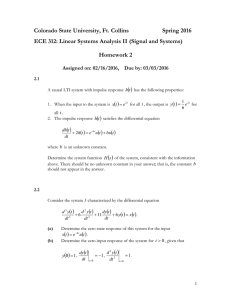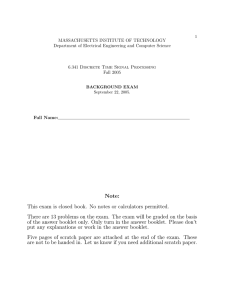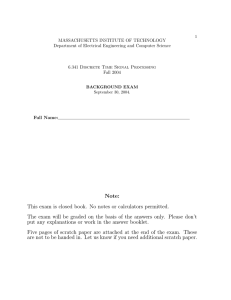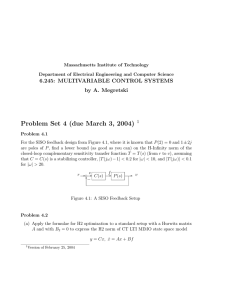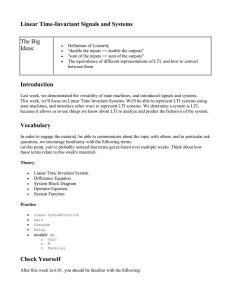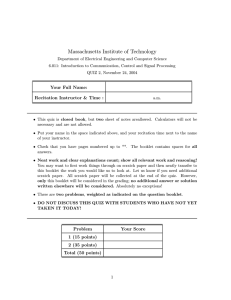linear time-invariant systems and their frequency response
advertisement
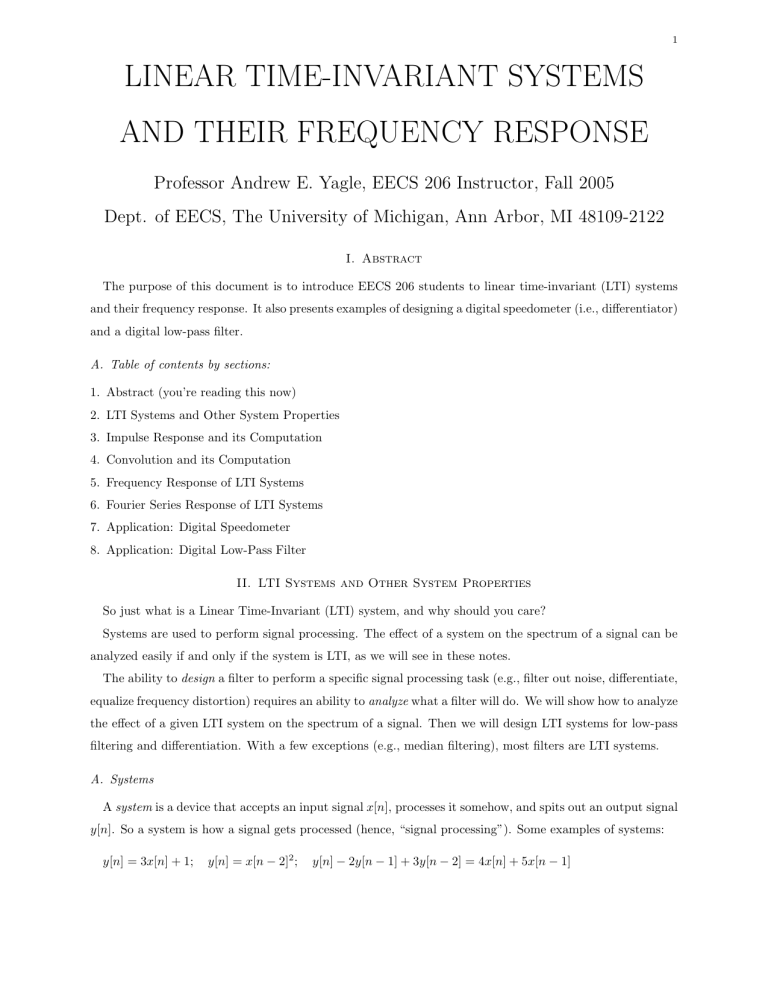
1
LINEAR TIME-INVARIANT SYSTEMS
AND THEIR FREQUENCY RESPONSE
Professor Andrew E. Yagle, EECS 206 Instructor, Fall 2005
Dept. of EECS, The University of Michigan, Ann Arbor, MI 48109-2122
I. Abstract
The purpose of this document is to introduce EECS 206 students to linear time-invariant (LTI) systems
and their frequency response. It also presents examples of designing a digital speedometer (i.e., differentiator)
and a digital low-pass filter.
A. Table of contents by sections:
1. Abstract (you’re reading this now)
2. LTI Systems and Other System Properties
3. Impulse Response and its Computation
4. Convolution and its Computation
5. Frequency Response of LTI Systems
6. Fourier Series Response of LTI Systems
7. Application: Digital Speedometer
8. Application: Digital Low-Pass Filter
II. LTI Systems and Other System Properties
So just what is a Linear Time-Invariant (LTI) system, and why should you care?
Systems are used to perform signal processing. The effect of a system on the spectrum of a signal can be
analyzed easily if and only if the system is LTI, as we will see in these notes.
The ability to design a filter to perform a specific signal processing task (e.g., filter out noise, differentiate,
equalize frequency distortion) requires an ability to analyze what a filter will do. We will show how to analyze
the effect of a given LTI system on the spectrum of a signal. Then we will design LTI systems for low-pass
filtering and differentiation. With a few exceptions (e.g., median filtering), most filters are LTI systems.
A. Systems
A system is a device that accepts an input signal x[n], processes it somehow, and spits out an output signal
y[n]. So a system is how a signal gets processed (hence, “signal processing”). Some examples of systems:
y[n] = 3x[n] + 1;
y[n] = x[n − 2]2 ;
y[n] − 2y[n − 1] + 3y[n − 2] = 4x[n] + 5x[n − 1]
2
The last equation makes these important points:
•
The output y[n] at time n can depend on the present input x[n], past inputs x[n − 1], x[n − 2] . . . and
future inputs x[n + 1], x[n + 2] . . ., and on known functions of n;
•
The output y[n] can also depend on past values of itself: y[n − 1], y[n − 2] . . .
•
The system equation need not be an explicit formula y[n] = F (x[n], x[n − 1] . . . , y[n], y[n − 1] . . .), although
it should be theoretically possible to write such a formula.
A system is often designated using the diagram x[n] → SYSTEM → y[n]. Note that this does not mean
that y[no ] depends only on x[no ]. The complete output {y[n]} depends on the complete input {x[n]}.
A system can be a mathematical model of a real-world device, derived using equations of biology, economics, or some other discipline. Some examples of such models:
•
Biology: Population models in which x[n] is some environmental factor and y[n] is the population of some
species in generation n;
•
Economics: Stock market models in which x[n] is the federal reserve interest rate and y[n] is the daily Dow
Jones close at the end of day n.
Note these are all discrete-time systems. In continuous time, systems can be used to model almost any
physical phenomenon (e.g., circuits in EECS 215 or 314).
However, in EECS 206 we will design discrete-time systems to accomplish a specific task, e.g., filter a
sampled continuous-time noisy signal. How are we able to do this?
B. Linear Systems
A linear system has the property that its response to the sum of two inputs is the sum of the responses
to each input separately:
x1 [n] → LIN → y1 [n] and x2 [n] → LIN → y2 [n] implies (x1 [n] + x2 [n]) → LIN → (y1 [n] + y2 [n])
This property is called superposition. By induction, this immediately extends to any number of inputs.
Superposition also implies that scaling the input x[n] by a constant a scales the output by a as well:
x[n] → LINEAR → y[n] implies
ax[n] → LINEAR → ay[n]
This property is called scaling. Although it is listed as a separate property, it follows from superposition.
To see this, let’s use the notation x[n] → y[n] as a shorthand to designate that input signal {x[n]} results in
output signal {y[n]}. Let a =
1. Let
x[n]
n
m
n,
where m and n are integers, be any rational number. Then we have:
→ z[n] where output z[n] is something we wish to determine.
2. Use superposition on n identical inputs
3. So z[n] =
y[n]
n
and
x[n]
n
→
x[n]
n
:
Then n x[n]
n = x[n] → y[n] = nz[n].
y[n]
n ,
4. Use superposition on m identical inputs
x[n]
n
:
y[n]
Then m x[n]
n = ax[n] → m n = ay[n].
3
So the superposition property implies the scaling property for any rational number a. To extend this
result to any real a actually requires some high-level mathematical analysis, but since any real number is
arbitrarily close to a rational number, we can fudge the result in EECS 206.
How can you tell whether a system is linear? You have been exposed to enough linear operators
in Math 115 and 116 that your intuition will work, with one exception noted below (affine systems). But if
your intuition isn’t working, the following rule often works:
If doubling the input doubles the output, then often the system is linear
This is not always true: the system y[n] =
y[n]2
x[n]
+ x[n] has this property but is not linear. But this rule
usually works. Note the rule is just the scaling property for a = 2.
To implement this test, you can use either of two methods:
•
Replace {x[n]} with {2x[n]} and {y[n]} with {2y[n]}, and see if you can reduce to the original equation;
•
Or: Double the entire equation, and see if you can pull out {2x[n]} and {2y[n]} everywhere.
•
Here {x[n]} means x[n], x[n − 1], x[n − 2] . . . x[n + 1], x[n + 2] . . .
Example: y[n] = 3x[n] is linear since (2y[n]) = 3(2x[n]) reduces to y[n] = 3x[n].
Example: y[n] = 3x[n] is linear since doubling it yields 2y[n] = 6x[n] → (2y[n]) = 3(2x[n]).
Example: y[n] = x[n]2 is not linear since (2y[n]) = (2x[n])2 does not reduce to y[n] = x[n]2 .
Of course, here it is easy to see that doubling the input quadruples the output.
Example: y[n]− 2y[n− 1]+ ny[n− 2] = 3x[n]+ 4x[n− 1] is linear since doubling it yields 2y[n]− 4y[n− 1]+
2ny[n − 2] = 6x[n] + 8x[n − 1] which becomes (2y[n]) − 2(2y[n − 1]) + n(2y[n − 2]) = 3(2x[n]) + 4(2x[n − 1]).
Note that you don’t need an explicit formula for y[n] in terms of {x[n]} here. In fact, you can easily show
that superposition holds for this equation:
y1 [n] − 2y1[n − 1] + ny1[n − 2] = 3x1 [n] + 4x1 [n − 1] and y2 [n] − 2y2[n − 1] + ny2[n − 2] = 3x2 [n] + 4x2[n − 1]
implies (y1 [n]+y2 [n])−2(y1 [n−1]+y2[n−1])+n(y1[n−2]+y2[n−2]) = 3(x1 [n]+x2 [n])+4(x1 [n−1]+x2[n−1])
Nonlinear Systems: y[n] = sin(x[n]);
y[n] = |x[n]|;
y[n] =
x[n]
x[n−1] ;
y[n] = x[n] + 1
That last one is tricky–it’s graph is a straight line, but it isn’t linear (doubling x[n] does not double y[n]).
This is called an affine system; “affine” means “linear+constant.”
C. Time-Invariant Systems
A time-invariant (TI) system has the property that delaying the input by any constant D delays the output
by the same amount:
x[n] → TIME-INVARIANT → y[n] implies
x[n − D] → TIME-INVARIANT → y[n − D]
A time-invariant system thus has no internal clock–it does not know that the input is delayed.
4
How can you tell whether a system is time-invariant? Here there is a simple rule that works:
If n appears only inside brackets (like x[n − 1]), then the system is TI .
Note that, inside brackets, shifts are acceptable but scales are not: x[n − 2] is OK but x[2n] and x[−n]
are not (note time reversal x[−n] is a scaling). Also, weird dependencies like x[n2 ] are not acceptable.
TI, not Linear: y[n] = x[n]2 ;
y[n] = |x[n] + x[n − 1]|;
Linear, not TI: y[n] = nx[n];
y[n] = x[2n];
y[n] = sin(x[n]);
y[n] = sin(n)x[n];
y[n] =
x[n]
x[n−1] .
y[n] − ny[n − 1] = 2x[n] + 3x[n − 1].
D. Linear Time-Invariant (LTI) Systems
An LTI system is one that is both linear and time-invariant (surprise). The LTI systems that will be of
particular interest in EECS 206 are AutoRegresive Moving-Average (ARMA) difference equations:
y[n] + a1 y[n − 1] + a2 y[n − 2] + . . . + aN y[n − N ] = b0 x[n] + b1 x[n − 1] + . . . + bM x[n − M ]
|
{z
} |
{z
}
AUTOREGRESSIVE(AR)
MOVING AVERAGE(MA)
This ARMA difference equation of order (N,M) is a discrete-time analogue of a differential equation.
An autoregression is a computation of a signal y[n] from its N past values {y[n − 1], y[n − 2] . . . y[n − N ]}.
Regression analysis is an attempt to compute future values from past values, such as stock market closes.
A moving average is a weighted linear combination of present value x[n] and M past values {x[n− 1], x[n−
2] . . . x[n − M ]}. It’s called a moving average since the quantities being averaged move as time progresses.
An ARMA difference equation can be implemented recursively in time n by rewriting it as
y[n] = b0 x[n] + . . . + bM x[n − M ] − a1 y[n − 1] − . . . − aN y[n − N ]
In Matlab, use y=filter([b0 b1. . .bM],[1 a1. . .aN],X].
A Moving Average (MA) difference equation of order M has just the MA part:
y[n] = b0 x[n] + b1 x[n − 1] + . . . + bM x[n − M ]
We will focus on MA systems (described by MA difference equations) in these notes. For ARMA systems,
we need the z-transform (covered in the next set of notes).
The following problem shows how useful the concept of LTI can be.
Given the following two input-output pairs: {1,3}→ LTI →{1,5,6} and {2,7}→ LTI →{2,11,14}
Compute the response to {6,7}.
Solution: Using linearity, {2,7}-2{1,3}={0,1}→ LTI →{2,11,14}-2{1,5,6}={0,1,2}
Using time-invariance, we can advance the output in time by 1 to get {0,1,0}→ LTI →{1,2}
Using superposition on the responses to δ[n] and δ[n − 1], we have
{6,7}=6{0,1,0}+7{0,1}→ LTI → 6{1,2}+7{0,1,2}= {6,19,14} .
5
This example suggests that once we know the response to {0,1,0}=δ[n], we can find the response to any
input. This is indeed the case, as we show later.
III. Impulse Response and its Computation
The impulse response h[n] of an LTI system is just the response to an impulse: δ[n] → LTI → h[n].
The significance of h[n] is that we can compute the response to any input once we know the response to
impulse. We will derive an explicit formula in the next section. This section will focus on computing h[n].
MA System: We can just read off h[n] from its coefficients. Setting x[n] = δ[n] and y[n] = h[n],
y[n] = b0 x[n]+b1 x[n−1]+. . .+bM x[n−M ] → h[n] = b0 δ[n]+b1 δ[n−1]+. . .+bM δ[n−M ] = {b0 , b1 . . . bM }
Example: For y[n] = 2x[n] + x[n − 2] + 4x[n − 3], we have h[n] = {2, 0, 1, 4}. Don’t forget the zero!
1st -order AR System: This is the one AR system we can analyze without the z-transform (see the next
set of notes for that). We wish to compute the impulse response h[n] for y[n] − ay[n − 1] = bx[n].
Setting x[n] = δ[n] and y[n] = h[n] and n = 0, 1, 2 . . . yields
n = 0 → h[0] − ah[−1] = bδ[0] = b → h[0] = b
n = 1 → h[1] − ah[0] = bδ[1] = 0 → h[1] = ba
n = 2 → h[2] − ah[1] = bδ[2] = 0 → h[2] = ba2
n = 3 → h[3] − ah[2] = bδ[3] = 0 → h[3] = ba3
An induction argument confirms h[n] = ban u[n]. Using LTI, the response to bk δ[n − k] is bk an−k u[n − k].
y[n] − ay[n − 1] = b0 x[n] + . . . + bM x[n − M ] → h[n] = b0 an u[n] + b1 an−1 u[n − 1] + . . . + bM an−M u[n − M ]
ARMA difference equations with AR-part order N ≥ 2 will have to wait for the z-transform, in the next
set of notes. But see again how powerful the concept of LTI can be?
IV. Convolution and its Computation
A. Derivation of Convolution
For LTI systems, we now show how to compute the response to any input from the impulse response h[n]:
1. δ[n] → LTI → h[n] (Definition of impulse response)
2. δ[n − i] → LTI → h[n − i] (Time-invariance–works for any constant i)
3. x[i]δ[n − i] → LTI → x[i]h[n − i] (Scaling property of Linear–works for any constant x[i])
P∞
P∞
4.
i=−∞ x[i]δ[n − i] → LTI →
i=−∞ x[i]h[n − i] (Superposition property of Linear)
When you have no idea what to make of a summation, like the one here, try writing it out explicitly. And
if it goes from −∞ to ∞, write out the terms for positive and negative indices separately. Here, this gives
P∞
i=−∞
x[i]δ[n − i] = x[0]δ[n] + x[1]δ[n − 1] + x[2]δ[n − 2] + . . . + x[−1]δ[n + 1] + x[−2]δ[n + 2] + . . .
= {. . . x[−2], x[−1], x[0], x[1], x[2] . . .} = x[n].
6
So
P∞
i=−∞
x[i]δ[n − i] = x[n]! And the response of the LTI system to any input x[n] is
x[n] → LTI → y[n] =
P∞
i=−∞
x[i]h[n − i] = h[n] ∗ x[n]
This is called the convolution of the two signals {h[n]} and {x[n]}, because it is so convoluted (scrambled).
Again, writing out the summation explicitly makes things clearer. Let h[n] = 0 for n < 0. Then we have
y[n] = h[n] ∗ x[n] = h[0]x[n] + h[1]x[n − 1] + h[2]x[n − 2] + h[3]x[n − 3] + . . .
which looks like a MA difference equation. Examples of computing convolution will be given below.
P
Remember, x[n] → LTI → y[n] = h[n] ∗ x[n] = x[i]h[n − i]
B. Causal and Stable Systems
Some quick definitions (if you think you understand these, you do):
•
A signal x[n] is causal if and only if x[n] = 0 for all n < 0.
•
x[n] is causal if and only if x[n]u[n] = x[n] (think about it).
•
An LTI system is causal if and only if its impulse response h[n] is causal.
•
All real-world systems are causal; otherwise they could see into the future!
•
A signal x[n] is bounded if and only if |x[n]| ≤ M for some constant M .
•
Example: 3 cos(2n + 1) is bounded (but not periodic) since |3 cos(2n + 1)| ≤ 3.
•
Example: Causal ( 12 )n u[n] is bounded but non-causal ( 21 )n is not bounded.
A system is BIBO stable (Bounded-Input-Bounded-Output) if and only if any Bounded Input results in
a Bounded Output (again, sensible nomenclature!). How are you supposed to know whether this is true?
Theorem: An LTI system is BIBO stable if and only if its impulse response is absolutely summable, i.e.,
P∞
n=−∞ |h[n]| < ∞, i.e., is a finite number.
What’s the difference between summable and absolutely summable? Consider:
P
h[n] = 1 − 21 + 31 − 41 + 51 − 61 + . . . = loge 2 = 0.693.
P
|h[n]| = 1 + 21 + 31 + 14 + 51 + 61 + . . . → ∞.
Proof: Since this is an “if-and-only-if” proof, there are two parts to it.
P
|h[n]| = N for some N .
Sufficiency: Suppose that h[n] is absolutely summable:
Now prove that the system is BIBO stable. How do we do this?
Suppose further that x[n] is bounded: |x[n]| ≤ M for some M . Now prove that y[n] is bounded:
P
P
P
|y[n]| = |h[n] ∗ x[n]| = | h[n − i]x[i]| ≤
|h[n − i]| · |x[i]| ≤ |h[n − i]|M = N M ,
using the triangle inequality. Q.E.D. (Latin for, “Thank God that’s over”).
Necessity: Suppose that h[n] is not absolutely summable. Then the response to the non-causal input
P
h[−n]
at n = 0 is y[0] = |h[n]| → ∞, so this bounded input produces an unbounded output.
x[n] = |h[−n]|
Note that any MA system is BIBO stable , since there are only a finite number of non-zero |h[n]|.
7
Example: h[n] = an u[n] is BIBO stable if and only if |a| < 1 since then
P∞
n=−∞
|h[n]| =
P∞
n=−∞
|a|n u[n] =
P−1
−∞
0+
P∞
n=0
|a|n =
1
1−|a|
< ∞.
Note how to handle the step function u[n] inside the summation: break up the sum into two parts.
Example: h[n] = {2, 3, −4} →
Example: h[n] =
Example: h[n] =
P
|h[n]| = |2| + |3| + | − 4| = 9 < ∞ → BIBO stable (MA system).
P
P
1
|h[n]| = | − 12 |n = 1−0.5
< ∞ → BIBO stable.
(− 21 )n u[n] →
n
P
P
(−1)
1
|h[n]| =
n+1 u[n] →
n+1 u[n] → ∞ → NOT BIBO stable.
No, “BIBO stable” is not a hobbit from “Lord of the Rings” (although it does sound like one).
BIBO stability is a necessity if you don’t want smoke coming out of your system!
C. Properties of Convolution
Basic Properties: You should be able to prove these yourself immediately:
•
(ah[n]) ∗ x[n] = h[n] ∗ (ax[n]) = a(h[n] ∗ x[n]) (scaling property)
•
x[n] ∗ δ[n] = x[n] and x[n] ∗ δ[n − D] = x[n − D] (sifting property)
•
h[n − D] ∗ x[n] = h[n] ∗ x[n − D] = y[n − D] where y[n] = h[n] ∗ x[n] (delay property)
•
This is very useful for signals that don’t start at n = 0
•
(causal signal)∗(causal signal)=causal signal.
Commutative: h[n] ∗ x[n] = x[n] ∗ h[n] =
P
x[i]h[n − i] =
P
h[i]x[n − i].
Significance: The order in which two signals are convolved doesn’t matter. This means that we can
exchange input and impulse response and get the same output:
x[n] → h[n] → y[n] gives same output as h[n] → x[n] → y[n].
Associative: (x[n] ∗ y[n]) ∗ z[n] = x[n] ∗ (y[n] ∗ z[n])
Significance: The overall impulse response of two LTI systems connected in series or cascade is the
convolution of their individual impulse responses:
x[n] → g[n] → h[n] → y[n] same as x[n] → h[n] ∗ g[n] → y[n].
To see this, let z[n] be the signal between the two systems. Then we have z[n] = g[n] ∗ x[n] and y[n] =
h[n] ∗ z[n] so that y[n] = h[n] ∗ (g[n] ∗ x[n]) = (h[n] ∗ g[n]) ∗ x[n].
Distributive: (x[n] + y[n]) ∗ z[n] = x[n] ∗ z[n] + y[n] ∗ z[n]
Significance: The impulse response of two LTI systems in parallel is sum of their impulse responses:
x[n]
-
h[n]
g[n]
?
+i
6
- y[n] same as x[n]
- h[n] + g[n]
To see this, note that y[n] = h[n] ∗ x[n] + g[n] ∗ x[n] = (h[n] + g[n]) ∗ x[n].
- y[n]
8
D. Computation of Convolution
How do you go about computing h[n] ∗ x[n] =
Two Finite-Duration Signals:
P
x[i]h[n − i] =
P
h[i]x[n − i]?
•
h[n] = {h[0], h[1] . . . h[L − 1]} is causal, has finite duration L and support [0, L − 1].
•
x[n] = {x[0], x[1] . . . x[M − 1]} is causal, has finite duration M and support [0, M − 1].
•
y[n] = {y[0] . . . y[L + M − 2]} is causal, has finite duration L + M − 1 and support [0, L + M − 2].
•
Note duration(h[n] ∗ x[n])=duration(h[n])+duration(x[n])−1: don’t forget that “−1.”
•
Note causal∗causal=causal. This makes sense–how can there be any output before any input?
Example: Compute {1, 2, 3} ∗ {4, 5, 6, 7} = {4, 13, 28, 34, 32, 21}:
•
y[0] = h[0]x[0] = (1)(4) = 04.
•
y[1] = h[1]x[0] + h[0]x[1] = (2)(4) + (1)(5) = 13.
•
y[2] = h[2]x[0] + h[1]x[1] + h[0]x[2] = (3)(4) + (2)(5) + (1)(6) = 28.
•
y[3] = h[2]x[1] + h[1]x[2] + h[0]x[3] = (3)(5) + (2)(6) + (1)(7) = 34.
•
y[4] = h[2]x[2] + h[1]x[3] = (3)(6) + (2)(7) = 32.
•
y[5] = h[2]x[3] = (3)(7) = 21.
•
Note: Length y[n]=Length h[n]+Length x[n] − 1 = 3 + 4 − 1 = 6.
In Matlab, use conv([1 2 3],[4 5 6 7]) to get the above answer.
If this looks like polynomial multiplication, that’s because it is. The z-transform uses this fact.
A much faster way to compute convolution is to use the Discrete Fourier Transform (DFT). We have:
y[n] = h[n] ∗ x[n] → DF T {y[n]} = (DF T {h[n]}) (DF T {x[n]})
•
All three DFTs have the same length; multiplication is for each k;
•
The DFT length≥duration of y[n] (otherwise this won’t work);
•
DFTs of length=power of 2 (e.g., 256 or 512 or 1024) can be computed quickly.
Example: Compute {1, 2} ∗ {3, 4} = {3, 10, 8} using a 4-point DFT (omit
SIGNAL
→
X0
X1
X2
X3
{1, 2, 0, 0}
→
3
1 − 2j
−1
1 + 2j
{3, 4, 0, 0}
→
7
3 − 4j
−1
3 + 4j
×↓
×↓
×↓
×↓
21
−5 − 10j
1
−5 + 10j
∗↓
{3, 10, 8, 0}
←
1
4
for clarity):
Matlab: real(ifft(fft([1,2],4).* fft([3,4],4))) This is much faster for long signals.
One Finite and One Infinite-Duration Signal:
To compute h[n] ∗ x[n], where h[n] has finite duration and x[n] has infinite duration, proceed as follows.
Assume WLOG (without loss of generality) that h[n] has duration L + 1 and is causal. Then we have
9
h[n] ∗ x[n]=(h[0]δ[n] + h[1]δ[n − 1] + . . . + h[L]δ[n − L]) ∗ x[n]=h[0]x[n] + h[1]x[n − 1] + . . . + h[L]x[n − L]
using linearity and the distributive property of convolution.
Example: Compute {2, −1, 3} ∗ ( 21 )n u[n] = 2δ[n] + 3( 21 )n−2 u[n − 2]:
•
{2, −1, 3} ∗ ( 12 )n u[n] = (2δ[n] − 1δ[n − 1] + 3δ[n − 2]) ∗ ( 21 )n u[n] =
•
2( 21 )n u[n] − 1( 21 )n−1 u[n − 1] + 3( 12 )n−2 u[n − 2] = 2δ[n] + 3( 12 )n−2 u[n − 2].
•
Aside: {2, −1} ∗ ( 21 )n u[n] = 2δ[n]. So we also have x[n] → ( 21 )n u[n] → {2,-1} → 2x[n].
V. Frequency Response of LTI Systems
We now show how to analyze the effect of a given LTI system on the spectrum of a signal fed into it.
While this may seem simple, it draws heavily on the material on LTI systems covered above.
A. Response to Complex Exponential Input
Let x[n] = ejωn be input into an LTI system with causal impulse response h[n]. The output is
y[n] = h[n] ∗ x[n] = h[n] ∗ ejωn =
H(ejω ) =
P∞
i=0
P∞
i=0
h[i]ejω(n−i) = ejωn
P∞
i=0
h[i]e−jωi = H(ejω )ejωn where
jω
h[i]e−jωi =Frequency Response=|H(ejω )|ejarg[H(e
)]
•
H(ejω )=frequency response function (a conjugate symmetric function of ω)
•
|H(ejω )|=gain function (an even function of ω)
•
arg[H(ejω )]=phase function (an odd function of ω)
•
H(ejω ) is periodic with period=2π
•
This is why I prefer to use H(ejω ) instead of H(ω)–as a reminder!
B. Response to Sinusoidal Input
Now let x[n] = cos(ωn) be input into an LTI system with causal impulse response h[n]. The output is
•
ejωn → LTI → H(ejω )ejωn
•
e−jωn → LTI → H(e−jω )e−jωn
•
Adding and using linearity and conjugate symmetry,
•
cos(ωn) → LTI → A cos(ωn + θ) where
•
A = |H(ejω )| and θ = arg[H(ejω )].
To see this in more detail, note the output y[n] when input x[n] = ejωn + e−jωn = 2 cos(ωn) is
jω
H(ejω )ejωn + H(e−jω )e−jωn = |H(ejω )|ejarg[H(e
jω
= |H(e )|[e
jω
jarg[H(e
)] jωn
e
+e
jω
−jarg[H(e
)] −jωn
e
)] jωn
e
+ |H(e−jω )|ejarg[H(e
−jω
jω
] = |H(e )|[e
jω
j(ωn+arg[H(e
)])
)] −jωn
e
jω
+ e−j(ωn+arg[H(e
)])
]
= |H(ejω )|2 cos(ωn + arg[H(ejω )]).
In summary: ejωn → LTI → H(ejω )ejωn and cos(ωn) → LTI → |H(ejω )| cos(ωn + arg[H(ejω )]) .
10
where H(ejω ) = h[0] + h[1]e−jω + h[2]e−j2ω + h[3]e−j3ω + . . . =frequency response function.
The response of an LTI system to a sinusoidal or complex exponential input is a sinusoid or complex
exponential output at the same frequency as the input. LTI systems cannot change frequencies.
C. Examples
Example: x[n] = cos( π2 n) → h[n] = {7, 4, 4} → y[n]. Compute y[n].
Solution: Proceed as follows:
•
H(ejω ) = 7 + 4e−jω + 4e−j2ω . This is a typical frequency response function.
•
H(ejπ/2 ) = 7 + 4e−jπ/2 + 4e−jπ = 7 − 4j − 4 = 3 − 4j = 5e−j0.927
•
cos( π2 n) → LTI → 5 cos( π2 n − 0.927) = {. . . 3, 4, −3, −4, 3, 4 . . .}
•
Confirm: {7, 4, 4} ∗ {. . . 1, 0, −1, 0, 1, 0 . . .} = {. . . 3, 4, 3, −4, 3, 4 . . .} omitting startup and ending.
Example: x[n] = 5 cos( π2 n) → h[n] = ( 12 )n u[n] → y[n]. Compute y[n].
Solution: Proceed as follows:
•
H(ejω ) = 1 + 12 e−jω + 41 e−j2ω + . . . =
•
H(ejπ/2 ) =
•
5 cos( π2 n) → LTI → 5(0.89) cos( π2 n − 0.464) = {. . . 4, 2, −4, −2, 4, 2 . . .}
•
Try doing this by convolving two infinite-duration signals–it’s difficult.
1
1−e−jπ/2 /2
=
1
1+j/2
1
.
1− 21 e−jω
j0.464
= 1/(1.12e
) = 0.89e−j0.464 .
Example: Compute gain functions for g[n] = {1, 1} and h[n] = {1, −1}.
Solution: Plugging into the definition of frequency response function, we have
g[n] = {1, +1} → G(ejω ) = 1 + e−jω = e−jω/2 (ejω/2 + e−jω/2 ) = 2 cos( ω2 )e−jω/2 .
h[n] = {1, −1} → H(ejω ) = 1 − e−jω = e−jω/2 (ejω/2 − e−jω/2 ) = 2 sin( ω2 )e−jω/2 j.
Now you have to be careful in taking magnitudes. The answers are low-pass and high-pass filters:
Gain functions=|G(ejω )| = 2| cos( ω2 )| (low-pass) and |H(ejω )| = 2| sin( ω2 )| (high-pass).
Try sketching these yourself to see how they complement each other.
VI. Fourier Series Response of LTI Systems
Who cares about the response to a single sinusoid or complex exponential? That is of little interest.
But using LTI (again), we can compute the response to any linear combination of sinusoids or complex
exponentials by taking the same linear combination of the responses to each individual sinusoid or complex
exponential. So we can find the response to a Fourier series, which means we can find the response to any
periodic function, and see immediately what its effect will be on its spectrum. That is of great interest.
A. Response to Discrete-Time Fourier Series
Again, we proceed in steps, using LTI along the way (see how useful and important LTI has become?):
k
:
1. ejωn → LTI → H(ejω )ejωn from above. Now set ω = 2π N
11
2. ej2πkn/N → LTI → H(ej2πk/N )ej2πkn/N . Using the scaling property:
3. xk ej2πkn/N → LTI → H(ej2πk/N )xk ej2πkn/N . Using superposition:
PN −1
P −1
j2πkn/N
j2πk/N
4.
→ LTI → N
)xk ej2πkn/N . Identifying Fourier series:
k=0 xk e
k=0 H(e
5. x[n] → LTI → y[n] where x[n] and y[n] have Fourier series expansions
PN −1
PN −1
6. x[n] = k=0 xk ej2πkn/N where xk = N1 n=0 x[n]e−j2πnk/N for k = 0, 1 . . . N − 1
PN −1
PN −1
7. y[n] = k=0 yk ej2πkn/N where yk = N1 n=0 y[n]e−j2πnk/N for k = 0, 1 . . . N − 1
8. yk = H(ej2πk/N )xk : The spectrum of x[n] has been altered by multiplication by H(ejω )
Use this to compute the response of an LTI system to an input whose Fourier series expansion is known:
B. Examples
Example: x[n] = 1 + 2 cos( π2 n) + 3 cos(πn) → h[n] = ( 21 )n u[n] → y[n]. Compute y[n].
Solution: Compute the response to each input term separately, and then add the results:
x[n] term:
1
2 cos( π2 n)
3 cos(πn)
jω
H(e )=:
1
1− 12 1
1
1− 21 (−j)
1
1− 12 (−1)
Simplifies to:
2ej0
0.89e−j0.464
2 j0
3e
y[n] term:
2
1.78 cos( π2 n − 0.464)
2 cos(πn)
y[n] = 2 + 1.78 cos( π2 n − 0.464) + 2 cos(πn). OK, but so what? Try a different system:
Example: x[n] = 1 + 2 cos( π2 n) + 3 cos(πn) → h[n] = {1, 0, 1} → y[n]. Compute y[n].
Solution: Now h[n] = {1, 0, 1} → H(ejω ) = 1 + e−j2ω = 2 cos(ω)e−jω . Now we have:
x[n] term:
jω
H(e )=:
2 cos( π2 n)
1
1+e
−j0
1+e
−jπ
3 cos(πn)
1 + e−j2π
Simplifies to:
2ej0
0 (!)
2ej0
y[n] term:
2
0 (!)
6 cos(πn)
y[n] = 2 + 6 cos(πn). The system killed off the cos( π2 n) component and doubled the remaining two
components. It filtered out that component and left the remaining components. It isn’t hard to see how:
{1, 0, 1} ∗ {. . . 1, 0, −1, 0, 1, 0 . . .} = {. . . 0, 0, 0, 0, 0, 0 . . .}
C. Notch Filters
Now that we can analyze a filter that eliminates a single frequency, let’s design a filter that will eliminate
any desired single frequency. It is easy to see that h[n] = {1, −2 cos(ωo ), 1} =notch filter yields
H(ejω ) = 1 − 2 cos(ωo )e−jω + e−j2ω = 2[cos(ω) − cos(ωo )]e−jω
which eliminates any term of the form A cos(ωo n + θ).
This is called a notch filter since its gain function looks like a notch chopped in a log with an axe.
12
Application: Why would you want to eliminate a single frequency anyways? Next time you are in a lab,
look around: there are electrical outlets and power cords everywhere. All of them are carrying electricity at
120 volts rms (170 volts amplitude!) and 60 Hertz. This radiates into the lab and induces 60 Hertz signals
in the leads to your oscilloscope, sensor, or any other measuring device. Proper grounding helps greatly, but
it does not eliminate the problem (remember this for EECS 215 or 314!). A notch filter can eliminate this.
If you are using a DSP system with 1 kHz sampling rate, then to eliminate 60 Hertz we need to use
Hz
ωo = 2π 60
1000 Hz = 0.377 → h[n] = {1, −1.86, 1} → y[n] = x[n] − 1.86x[n − 1] + x[n − 2]
To see why, recall that the spectrum of the sampled signal is periodic with period=sampling rate. Then:
Cont.-time frequency (Hz)
60
1000
Discrete-time frequency
60
2π 1000
2π
Also, note that dimensionally this is the only formula that makes sense!
A typical notch filter has a magnitude response that looks like this (note the notches):
1.5
1
0.5
−3
−2
−1
0
1
2
3
Matlab: W=linspace(-pi,pi,100);E=abs(cos(W)-cos(pi/3));subplot(311),plot(W,E),axis tight
Note that this filter also reduces all components with frequencies anywhere near ωo . Despite its name, it
is not a very selective filter. We will design much better filters for rejecting single frequencies in the next set
of notes, by using an ARMA, instead of just an MA, difference equation.
VII. Application: Digital Speedometer
A. Introduction
The notch filter represented the first time we actually designed a digital filter to perform a specific task. We
now design a digital speedometer (i.e., digital differentiator). Note how many different EECS 206 concepts
enter into the discussion to follow. There were good reasons for studying all of that material!
A speedometer is a device that computes instantaneous speed, which is the derivative with respect to time
of total distance travelled. The latter is measured using an odometer; this is our continuous-time input x(t).
The goal is to compute the continuous-time output speed=y(t) =
dx
dt
digitally.
We will use a DSP system with a 1 kHz sampling rate. Since x(t) varies very slowly (it gradually increases
with time, with no sudden changes or discontinuities), it is likely bandlimited to much less than 500 Hz. So
x(t) is heavily oversampled. This has two advantages:
13
•
We don’t need an anti-alias filter prior to sampling (A/D);
•
We can use a zero-order hold for the interpolator (D/A).
We will also omit all overall scale factors, to make the computation easier to follow.
B. Frequency Response of Differentiator
What should be the frequency response of our digital filter? This is the same as asking, what is the
continuous-time frequency response of a differentiator? To find out, let’s see what is the effect of differentiation on a complex exponential:
x(t) = ejωt →
dx
dt
= jωejωt → H(ω) = jω = |ω|ejsign(ω)π/2
where H(ω) is the continuous-time frequency response (the only difference from discrete time is that H(ω)
is no longer periodic with period=2π). So differentiation results in a gain proportional to the frequency and
a 90-degree phase shift (-90 degrees for negative frequencies).
Hence our desired discrete-time frequency response is H(ejω ) = jω for |ω| < π. Since H(ejω ) must be
periodic with period=2π, we use the periodic extension of jω, not jω itself (which is not periodic).
What LTI system impulse response h[n] results in an H(ejω ) that looks like this? You have seen how to
compute h[n] but in a completely different context. Stare at the figure for awhile before reading on.
1
0.5
0
−0.5
−1
−15
−10
−5
0
5
10
15
Since H(ejω ) is a continuous function of ω with period=2π, it has a Fourier series expansion in ω:
H(ejω ) = h0 + h1 ej2πω/T + h2 ej4πω/T + . . . + h−1 e−j2πω/T + h−2 e−j4πω/T + . . .
where T =period=2π and the Fourier series coefficients hk are computed from one period of H(ejω ) using
hk =
1
T
R T /2
−T /2
H(ejω )e−j2πkω/T dω =
1
2π
Rπ
−π
jωe−jkω dω =
(−1)k
−k
for k 6= 0 (and h0 = 0). What good does this do us? Comparing the previous equation with the definition
H(ejω ) = h[0] + h[1]e−jω + h[2]e−j2ω + . . . + h[−1]ejω + h[−2]ej2ω + . . .
(extended to non-causal h[n]), we see that h[−k] = hk ! So for a digital differentiator
h[n] = (−1)n /n = {. . . − 14 , 13 , − 12 , 1, 0, −1, 21 , − 13 , 14 . . .}
y[n] = h[n] ∗ x[n] = . . . + 13 x[n + 3] − 12 x[n + 2] + x[n + 1] − x[n − 1] + 21 x[n − 2] − 13 x[n − 3] + . . .
14
which is the digital filter for an ideal digital differentiator. Note that:
•
•
•
Since H(ejω ) = jω (in one period) is purely imaginary and odd, h[n] is also;
P
h[n] is non-causal and unstable, since
|h[n]| = 2(1 + 12 + 31 + . . .) → ∞
Truncating h[n] to {1, 0, −1} yields y[n] = x[n + 1] − x[n − 1], the central difference approximation
The overall system looks like this: x(t) → A/D → x[n] → h[n] → y[n] → D/A → y(t)
A/D: x[n] = x(t = n/1000). D/A: y(t) = y[n] for
n
1000
<t<
n+1
1000
=
n
1000
+ 0.001 (staircase function).
VIII. Application: Digital Low-Pass Filter
Problem: We are given the noisy signal shown below. Our goal is to filter out the noise.
All we know about the signal is the following:
•
It is periodic with period=0.2 seconds
•
It is bandlimited to about 20 Hz.
•
It is sampled at 1 kHz and we have 1000 samples
UNKNOWN SAMPLED NOISY SIGNAL
5
0
−5
0
100
200
300
400
500
600
700
800
900
1000
Solution: We can infer the following facts:
•
Since the signal has period=0.2 seconds, the fundamental frequency is 1/0.2=5 Hz.
•
The signal also has harmonics at 10,15,20 Hz; higher harmonics are negligible.
•
Sampling at 1000 Hz→signal better be bandlimited to 500 Hz.
•
Actually bandlimited to 20 Hz→ 25x oversampling (500/20=25).
•
(1000 samples)/(1000 Hz)=1 second duration=5(0.2 seconds)=5 periods given
•
Using a 1000-point DFT→following continuous-time and discrete-time frequencies:
Cont.-time frequency (Hz)
20
500
1000
Discrete-time frequency
π
25
π
2π
DFT frequency index k
20
500
none
This suggests the following filtering procedure:
•
Compute a 1000-point DFT of the noisy data;
•
Set the result=0 for 21 ≤ k ≤ 979 (Matlab indices: 22 ≤ k ≤ 980);
•
Keep: k = 0 (DC); 1 ≤ k ≤ 20 (positive frequencies); 980 ≤ k ≤ 999 (negative frequencies);
•
Compute a 1000-point inverse DFT of the result.
15
The result is shown below.
•
This is the way to do it if we already have all of the data before we start.
•
Matlab indexing: 1=DC; (6 and 996)=±5 Hz, (11 and 991)=±10 Hz, (16 and 986)=±15 Hz, etc.
•
Note that the noise was formed by taking differences between successive values of random numbers. From
the section on digital speedometers (differentiators), we know that this increases high-frequency components
and reduces low-frequency components. This makes the example more dramatic.
•
Since the signal has only 5 significant components (at 0,5,10,15,20 Hertz), can’t we just estimate 9 numbers
(the DC component is real) from the data? We certainly can, but such methods lie beyond EECS 206.
Matlab code for this example:
for I=0:2:8;X(100*I+1:100*I+100)=linspace(0,1,100);end
for I=1:2:9;X(100*I+1:100*I+100)=1-linspace(0,1,100);end
N=4*rand(1,1001);N=N(2:1001)-N(1:1000);Y=X+N;plot(Y)
FY=fft(Y);FY(22:980)=0;Z=real(ifft(FY));plot(Z)
FILTERED SAMPLED NOISY SIGNAL
1
0.5
0
0
100
200
300
400
500
600
700
800
900
1000
Sometimes we wish to filter the data as it arrives, without waiting for all of it. This is called real-time
signal processing. In this case, we can filter the data using the impulse response (note this is non-causal, but
we can delay it to make it causal; this then delays the output):
π
n)]/(πn) where sinc(x)=[sin(πx)]/(πx) is even and sinc(0)=1.
h[n] = sinc(n/25) = 25[sin( 25
h[n] comes from expanding the periodic function H(ejω ) =
in a Fourier series, as in the speedometer section. Filter:
(
1 for 0 ≤ |ω| < π/25;
0 for π/25 < |ω| ≤ π
.
2
1
1
2
y[n] = . . .+sinc( 25
)x[n + 2]+sinc( 25
)x[n + 1]+x[n]+sinc( 25
)x[n − 1] +sinc( 25
)x[n − 2] + . . .
In Matlab use Y=filter([sinc([-20:20]*pi/25)],1,X) to implement this (you may want to use a filter
length more that 2(20)=41). In EECS 451 and EECS 452 you will learn how to design optimal MA lowpass
filter using numerical optimization algorithms. If you can’t wait, try help remez in Matlab.
You have now learned how to: (1) eliminate individual frequencies; (2) filter noisy signals; (3) differentiate
signals. But how do you do other things? How do you take advantage of the AR part of ARMA difference
equations? For this, we need a powerful tool–the z-transform. See the next set of notes.


